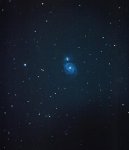KapHn8d
0
- Joined
- May 9, 2013
- Messages
- 838
- Points
- 43
I want one... really, I do. In fact, there were a couple of great multilines on LPF this past month that I fully intended to narrow to a purchase. I love that soothing 488nm beam and there is just something special about having a laser that needs me to snuggle it every month... not that it would have to ask. Kidding aside, the money tree isn't as prolific as I'd like and I had to make some choices. The argon will wait, since I've recently become infatuated with photographing the stars. I'm not really good at it yet, but I'm learning... and each time I go out, I get a little better. I thought I'd throw up a couple of my first attempts and see what y'all thought... be gentle.
M51, The Whirlpool Galaxy
M101, The Pinwheel Galaxy
M65 and the Leo Triplet
M81 and M82, Bode's Galaxy and the Cigar Galaxy
Have a great week, y'all!
/c
M51, The Whirlpool Galaxy
M101, The Pinwheel Galaxy
M65 and the Leo Triplet
M81 and M82, Bode's Galaxy and the Cigar Galaxy
Have a great week, y'all!
/c





